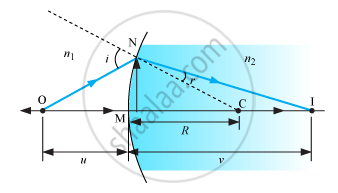Advertisements
Advertisements
प्रश्न
A point object is placed on the principal axis of a convex spherical surface of radius of curvature R, which separates the two media of refractive indices n1 and n2 (n2 > n1). Draw the ray diagram and deduce the relation between the object distance (u), image distance (v) and the radius of curvature (R) for refraction to take place at the convex spherical surface from rarer to denser medium.
उत्तर
A refracting surface which forms a part of a sphere of transparent refracting material is called a spherical refracting surface.

The above figure shows the geometry of formation of image I of an object O and the principal axis of a spherical surface with centre of curvature Cand radius of curvature R.
Assumptions:
(i) The aperture of the surface is small compared to other distance involved.
(ii) NM will be taken to be nearly equal to the length of the perpendicular from the point N on the principal axis.
`tan ∠NOM = (MN)/(OM)`
`tan ∠NCM =(MN)/(MC) `
`tan ∠NIM = (MN)/(MI)`
For ΔNOC, i is the exterior angle.
∴ i = ∠NOM + ∠NCM
`i = (MN)/(OM)+(MN)/(MC) ........... (1)`
Similarly, r = ∠NCM − ∠NIM
`i.e.,r = (MN)/(MC) - (MN)/(MI) ......(2) `
By Snell’s law,
n1sini = n2sinr
For small angles,
n1i= n2 r
Substituting the values of i and r from equations (i) and (ii), we obtain
`n_1( (MN)/(OM)+(MN)/(MC))= n_2((MN)/(MC) - (MN)/(MI)) `
or,`n_1/(OM) +n_2/(MI)= (n_2 - n_1)/(MC) ........... (3)`
Applying new Cartesian sign conventions,
OM = − u, MI = + v, MC = + R
Substituting these in equation (3), we obtain
`n_2/v-n_1/u = (n_2-n_1)/R ...... (4)`
Above equation is the required equation.
APPEARS IN
संबंधित प्रश्न
Use Gauss's law to find the electric field due to a uniformly charged infinite plane sheet. What is the direction of field for positive and negative charge densities?
Find the electric field intensity due to a uniformly charged spherical shell at a point (ii) inside the shell. Plot the graph of electric field with distance from the centre of the shell.
Find the ratio of the potential differences that must be applied across the parallel and series combination of two capacitors C1 and C2 with their capacitances in the ratio 1 : 2 so that the energy stored in the two cases becomes the same.
An infinitely large thin plane sheet has a uniform surface charge density +σ. Obtain the expression for the amount of work done in bringing a point charge q from infinity to a point, distant r, in front of the charged plane sheet.
Using Gauss's law in electrostatics, deduce an expression for electric field intensity due to a uniformly charged infinite plane sheet. If another identical sheet is placed parallel to it, show that there is no electric field in the region between the two sheets ?
A small conducting sphere of radius 'r' carrying a charge +q is surrounded by a large concentric conducting shell of radius Ron which a charge +Q is placed. Using Gauss's law, derive the expressions for the electric field at a point 'x'
(i) between the sphere and the shell (r < x < R),
(ii) outside the spherical shell.
A rubber balloon is given a charge Q distributed uniformly over its surface. Is the field inside the balloon zero everywhere if the balloon does not have a spherical surface?
A circular wire-loop of radius a carries a total charge Q distributed uniformly over its length. A small length dL of the wire is cut off. Find the electric field at the centre due to the remaining wire.
“A uniformly charged conducting spherical shell for the points outside the shell behaves as if the entire charge of the shell is concentrated at its centre”. Show this with the help of a proper diagram and verify this statement.
